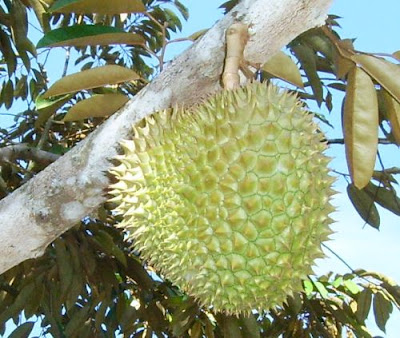The durian is the fruit of the trees of the genus Durio, belonging to the family Malvaceae. The fruit is much used and appreciated in Southeast Asia, and called there "the king of fruits." The fruit stands out for its huge size, unique odor and formidable shell protected by thorns.
The fruit can grow up to 30 centimeters in diameter and usually weighs one to three kilograms. Its shape can range from oblong to round, the color of the husk green to brown and the flesh pale yellow to red, depending on the species.
History
Durian has been known and consumed in Southeast Asia since prehistoric times, but has only been known in the Western world for about 600 years. The first known European reference to the fruit is from Niccolò Da Conti, who traveled to Southeast Asia during the 1400s. The Portuguese physicist Garcia de Orta described the fruit in Colóquios dos Simples e drugged da India which was published in 1563. In 1741 was published the work Herbarium Amboinense the German botanist Georg Eberhard Rumphius, which was the most accurate and detailed statement of the fruit during that century.
In 1949 published the British botanist EJH Corner, The Durian Theory, or the Origin of the Modern Tree . His theory was that the very first form of seed dispersal of plants by animals were transported seeds in the stomach, and that simple ancestors of Durio were the first plants to take advantage of this distribution method.
Since the early 1990s , the international demand for durian in ASEAN increased significantly, partly due to the increasing prosperity in Asia.
~~~
~~~
Uses
Durian fruit contains a high amount of sugar , vitamin C, potassium, and the serotonergic amino acid tryptophan, and is a good source of carbohydrates, proteins and fats. Among practitioners of live food is considered the fruit to be a excellent source of raw fats, while others consider it high-fat foods, why one should minimize the consumption of it.
The fruit can grow up to 30 centimeters in diameter and usually weighs one to three kilograms. Its shape can range from oblong to round, the color of the husk green to brown and the flesh pale yellow to red, depending on the species.
History
Durian has been known and consumed in Southeast Asia since prehistoric times, but has only been known in the Western world for about 600 years. The first known European reference to the fruit is from Niccolò Da Conti, who traveled to Southeast Asia during the 1400s. The Portuguese physicist Garcia de Orta described the fruit in Colóquios dos Simples e drugged da India which was published in 1563. In 1741 was published the work Herbarium Amboinense the German botanist Georg Eberhard Rumphius, which was the most accurate and detailed statement of the fruit during that century.
In 1949 published the British botanist EJH Corner, The Durian Theory, or the Origin of the Modern Tree . His theory was that the very first form of seed dispersal of plants by animals were transported seeds in the stomach, and that simple ancestors of Durio were the first plants to take advantage of this distribution method.
Since the early 1990s , the international demand for durian in ASEAN increased significantly, partly due to the increasing prosperity in Asia.
~~~
~~~
Uses
Durian fruit contains a high amount of sugar , vitamin C, potassium, and the serotonergic amino acid tryptophan, and is a good source of carbohydrates, proteins and fats. Among practitioners of live food is considered the fruit to be a excellent source of raw fats, while others consider it high-fat foods, why one should minimize the consumption of it.



No comments:
Post a Comment